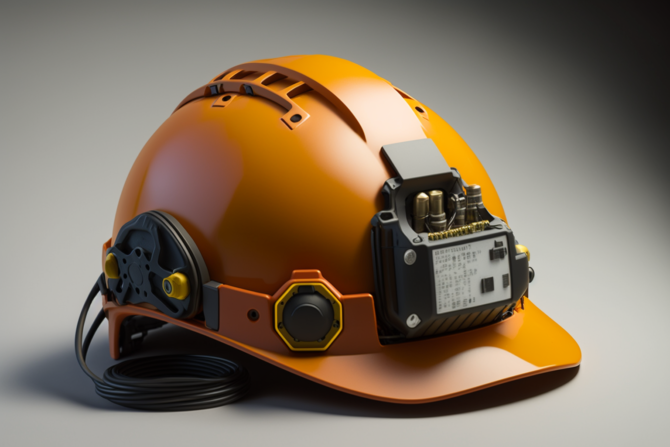
Preventing workplace injury with haptic technology
By Kyle Skippon, head of engineering, Titan Haptics
Electronics Editor Pick haptic injury Technology Titan workplaceFactories and warehouses are beginning to integrate robotics and other forms of machine automation into the workplace
At its core, technology is supposed to make people’s lives better, however, this can take many forms. Beyond just interconnecting people and finding new ways to entertain us, advances in technology truly have the potential to keep us safer and healthier than ever before.
One place where this is glaringly apparent is in the world of workplace injury. Today, injuries in the workplace are an epidemic, bringing significant detriment to the lives of millions of workers and cutting into the productivity of thousands of businesses. To answer this call, one field of technology with the potential to have a huge positive impact on preventing workplace injury is haptics.

Many haptics applications operate as an alarm to notify workers of dangerous scenarios. Source: Titan Haptics
Recently, Titan Haptics supported a hackathon at the Delft University of Technology, and it was here that the creativity of students really highlighted the role that haptics can play in preventing workplace injury. In this piece, we’ll discuss the growing role of tech in preventing workplace injury, a background on haptics, and dive deeper into the novel projects developed by the Delft University of Technology students.
Growing role of tech in workplace
Today, workplace injuries are becoming an alarmingly prominent issue in a variety of industries, but most specifically, in the blue-collar workplace. Fields requiring manual labour, like construction and warehouse work, are particularly afflicted – seeing a growing number of bodily injuries resulting from falling objects, improper technique, and general negligence.
From the employee’s perspective, a workplace injury can leave them injured, strip them of their livelihood, and significantly impact their quality of life. For the employer, workplace injury strains the employer-employee relationship and can cut into business productivity and profitability. In fact, it is estimated that over $250B is spent on workplace injuries every year in the US, while the global cost of workplace illnesses, injuries, and deaths totals $2.99 trillion dollars.

Source: Titan Haptics
As this epidemic continues to mount, many organizations are now turning to modern technology as a solution. For example, recent years have seen a handful of companies beginning to invest in worker-worn wearable safety devices. These devices are often equipped with a number of sensors that allow the device to track a worker’s movements and use advances in artificial intelligence and machine learning (AI/ML) to determine the wearer’s level of safety. In a situation like this, a wearable device might determine that a worker is using improper form (e.g., bending their back at an unsafe angle) and can alert the worker of the danger before any injury occurs.
Others in the industry are looking to prevent workplace injury by embracing the concepts of Industry 4.0 and Industry 5.0. Here, workplaces like factories and warehouses are beginning to integrate robotics and other forms of machine automation into the workplace to operate alongside human employees. In doing this, workplaces are increasing automation and offloading more dangerous tasks from humans to improve their safety. With the proliferation of technologies like these, the industry is addressing many of these concerns and creating a safer and more productive workspace.
A primer on haptics
Among these solutions, one field that is a large contributor to workplace tech is haptic technologies. Haptics technologies are devices and systems that enable users to experience touch and tactile feedback in virtual and real-world environments. On the whole, these systems tend to involve the use of sensors, actuators, and software algorithms integrated into a feedback loop to simulate touch sensations.
At the heart of a haptic system is the haptic actuator, which is the part of the system which physically creates forces or vibrates to produce tactile sensations. In general, haptic actuators are driven by a voltage waveform, the characteristics of which (i.e., amplitude, pulse width, duration), will directly influence the vibrations of the actuator. Some types of legacy haptic actuators include linear resonant actuators (LRAs) and eccentric rotating mass actuators (ERMs). More recently, advances in technology have led to the advent of voice coil motors (VCMs), and linear magnetic rams (LMRs), both of which offer a broader range of haptic feedback than legacy solutions.
Thanks to advances in haptics, the technology has found itself used in a plethora of devices and applications. More common uses for haptics include smartphones or AR/VR glasses, where the vibration caused by a haptic actuator can be used to alert a user of a notification or to create a realistic tactile experience. Now, however, many people are starting to integrate haptic technology into workplace tech as well.
In this context, many applications of haptics operate by using the haptics as a notification or alarm mechanism, alerting workers of dangerous scenarios or environments. Sticking with our example from earlier, a haptic-enabled workplace wearable might vibrate in a certain way when a wearer is detected to be bending their back in an unsafe way.
Student project on haptics
Recently, Titan Haptics supported a hackathon at the Delft University of Technology in which students competed to develop haptic-based projects. Here, two groups of students each particularly impressed the crowd with novel projects that directly tackled the challenge of workplace injury.
The first of these projects was a modular construction vest that was equipped with haptic feedback. Research shows that one of the most common causes of injury to a construction worker is being hit by random and falling objects. The goal of this project was to address this threat by creating a vest that would vibrate when it detected a nearby object endangering a wearer. To do this, the project integrated proximity sensors which could detect the presence of a nearby object, upon which haptic feedback would alert the wearer of the impending danger through vibrations. Akin to a “sixth sense” on the construction site, this project, showed tremendous potential in directly addressing a common cause of workplace injury in the construction industry.
The second hackathon project that addressed workplace injury came in the form of an intelligent safety helmet for construction workers. For this project, students sought to address the issue of workers getting overheated and dehydrated on the job which can lead to a significant risk of harm. To address this, the students devised a haptic-enabled construction helmet that consisted of a suite of sensors, including temperature sensors that could detect when a worker was overheating or overworking. In response to these triggers, the helmet would provide a variety of different tactile feedback that depended on the severity of the situation. For example, if the detected temperature was high, but not immediately dangerous, the helmet might provide the wearer with a pulsating vibration to indicate a small warning. If workers reached a serious risk of injury from overheating, however, the helmet might provide more aggressive and noticeable vibrations to warn the wearer of the danger.
In both instances, students successfully demonstrated how innovative technology equipped with haptic feedback could directly improve lives and prevent injury in the workplace.
Conclusion
As workplace injury continues to be a serious problem in blue-collar America, the need for solutions has never been greater. Fortunately, today, modern technology is starting to play an important role in workplace injury prevention.
Within this, haptic technology is finding itself more and more integral to the solution, providing a way to physically alert workers of dangerous scenarios and environments. As impressively demonstrated by the students at the Delft University of Technology, the applications for haptics in this context are far-reaching, and the impact could be tremendous. Because of this, at Titan Haptics, we believe that haptic technology can play an important role in the future of workplace injury prevention and can ultimately lead to safer workplaces and more productive businesses.
———————————————————–
Titan Haptics develops advanced haptic motors for smartphones, consoles and touchscreen devices.
